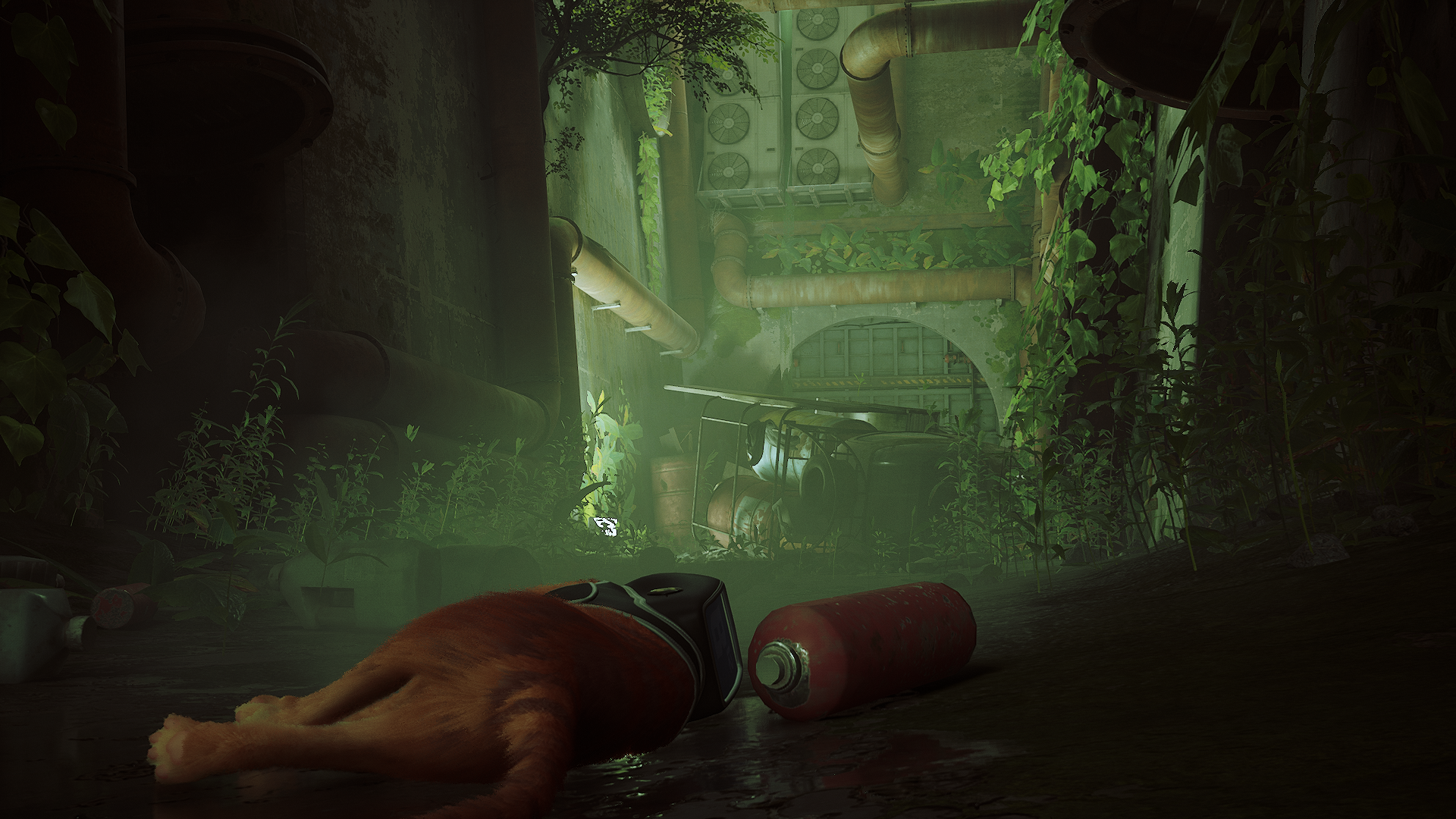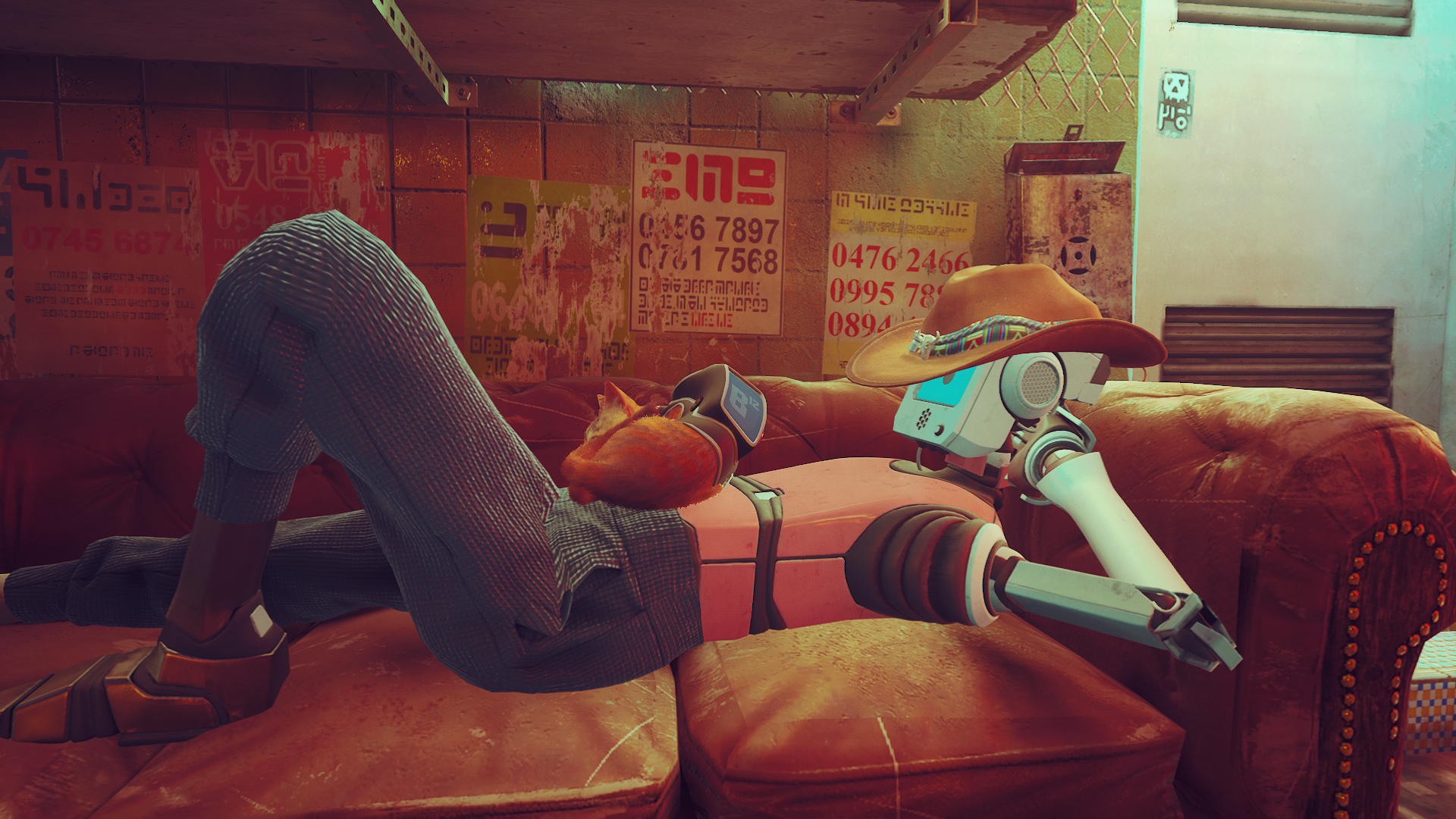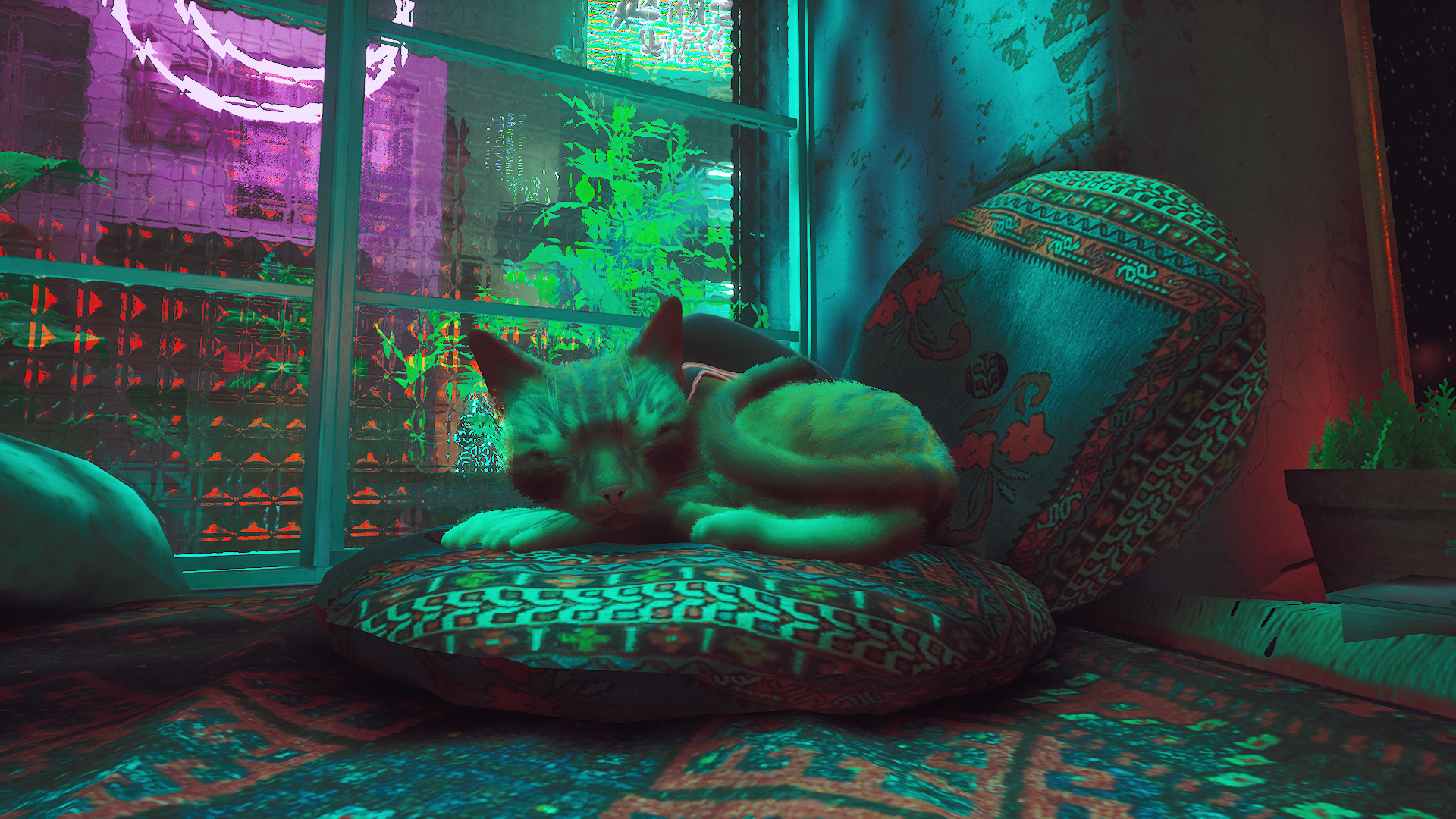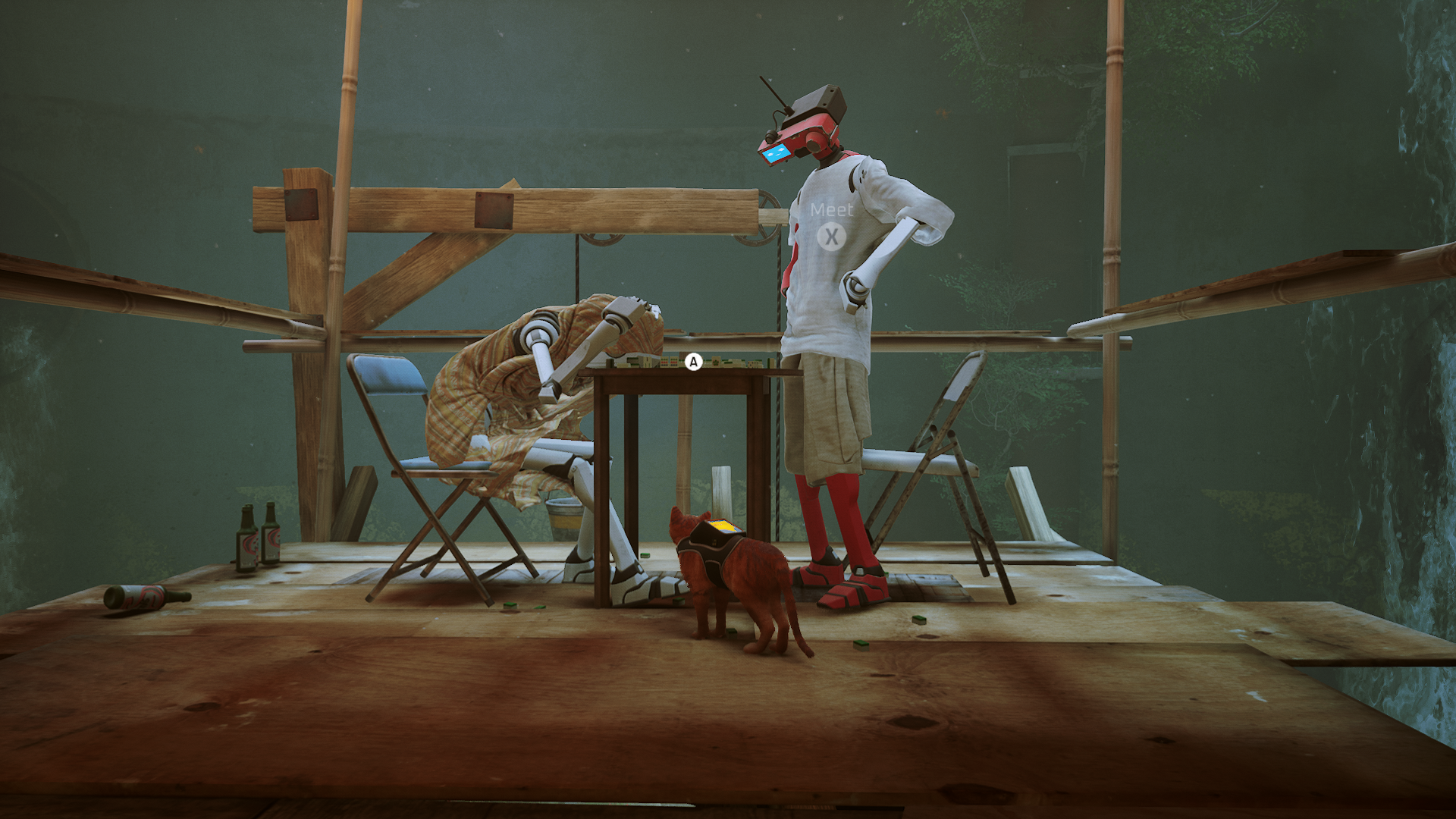Better late than never. Released in 2022, Stray is an adventure game that lets you play as a cat who fell in an underground world. A couple of months short of 3 years later, I’ve decided to dive into this deserved high-praise masterpiece.

I’ve never owned a cat but Stray’s concept picked my interest. Being able to incarnate a small cat in a fictional cyberpunk world with friendship and journey themes in the background was enticing, especially since the art direction looked promising, leading to an immersive experience.

As soon the game starts, the menu theme sets the tone. Slow, enveloping, dark with a sliver of hope. I’m starting a new game and I’m ready to control an orange cat whose agility is critically higher than a popular lasagna-eating orange cat’s. The scenery is eye candy. A red title appears at the middle of the screen, written in an unknown alphabet, subtitled in English and I can start carefully moving the little furball. His movement is natural, smooth, reactive and the controller-based gameplay is intuitive. I can walk, run, jump, meow, scratch and even groom my fellows. I’m taking a walk along my family, I’m watching and listening to my immediate surroundings which are full of details. Soon is time for the adventure to start. The screen gets darker and grimmer, while keeping its splendour. The screens and scenes are naturally flowing and I can perfectly make use of my natural agility and abilities. I love being able to jump, to knock things off, to carry objects to interact with my surroundings and even open the way forward. Eventually, my paws are landing into a small cosy apartment which looks so nice and real that I could see myself live in and I finally meet an unexpected kind of friend who is going to share the next handful of hours with me.

Unexpected friendships is part of what Stray is about. This little robot, named B-12 (a not so obscure reference to the studio’s name) is going to be our guide in this tight but incredible world we fell in. Thanks to B-12’s translation ability, our four-legged hero will be able to communicate, interact, help the screen-faced robot inhabitants and encounter some rebels, guitar players, nerds, bartenders, shopkeepers or poor sods just trying to survive in a hostile world. Another main component of Stray is survival. Soon enough, the world will reveal itself as hostile and deadly, and not only towards the protagonist. Blobs born out of rotten trash, zealous sentries, robots without morale… The stray cat will need to use both his celerity and agility to accomplish what his new friends tasked him so he can be helped rejoining his family.

These matters are perceived through a magnificent showcase, nothing less. The art direction is breathtaking and spotless. The lightning creates such living urban neighbourhoods with the typical cyberpunk flashing colours along with well-crafted interiors that really convey their own atmosphere, going from the cosy place that looks like a sanctuary to the rebel hideout, without skipping the busy nightclub or bar. From the Slums to Midtown through Antvillage and the Sewers, the exteriors have been designed with the same love – you find yourself feeling oppressed by some gloomy corridors or rooftops and later scratching like a DJ or purring next to a lady watering her flowers in a vertical urban area that’s like a tree. All the possible interactions with the robots are expressive – they smile, they love, but they can also be pissed at one another, or just with you. It feels simple but that’s also a trademark: the game doesn’t focus on over-delivering things and lets the player enjoy and appreciate the developer’s craftsmanship and thoughtfulness over what can be considered small things. Last but not least, the soundtrack is on par for the course and a masterpiece on its own. You can always hear it, it never distracts you but turn it off and you’ll hear the difference as it holds the different pieces together.

You may as well forget that you’re not playing as a human but as a cat since the gameplay feels innate and there’s so much to explore or interact with. The adventure and story both unveil flawlessly at a perfect pace all throughout the story. The world is your playground, and you’re free to roam around in the open areas, minding the danger in the more closed spaces. Many secrets, those being story-driven collectibles or characters with dialogues, are being hidden in many nooks and crannies you’re not necessarily being told to go to, but you’re going nonetheless because you’ll end up jumping from AC units to balconies and awnings. The lack of HUD also reinforces this feeling of actively being in the world as a living part of it, and not as an asset controlled by the player; the sense of wonder when you find something or you seem to look at a new area you’ve not discovered before, because you don’t know if what you found is tied to progress, or is just a small nugget of the atmosphere, or a collectible tied to an optional request someone could have for you. The game purposefully but subtly calls for the player’s curiosity and will to talk with the inhabitants, to share their stories, their lives, their fate, to cause mischief, to trade, to be part of this world, with humanity – despite said world not featuring any human beings. One thing leading to another, we’re learning why some robots are living in the Slums while some others are in the nicer Midtown area, why there is deadly blobs born from the trash thrown by a megacorp, why there is a rebellion movement, and such. The story is carefully backed by a “Memory” collectible system in which you have to help B-12 remember what happened to humanity by interacting by both mandatory and optional pictures, robots, landscapes or items. These collectibles help unveil critical pans of the story, which feels so real and plausible in a not-so-distant future. All these ingredients cooked together get the player emotionally attached towards the cat, but also to the drone and the friends you’ll make along the way, be it for a couple of minutes or through multiple areas.

Stray’s ode to simplicity and connection to deep themes like life and death and friendship, betrayal, attachment and parting – and this, no matter the species – is the main strength of the game. Stray precisely and finely delivers: the world isn’t too constrained but neither you ever feel lost, it doesn’t pad its completion time with filler content or frustrating difficulty and it never nags you with extra paid bullshit, far away from some entertainment companies’ disgusting methods and trends to rake some extra cash. The compelling characters, the gut-wrenching story full of lessons, the fictive human-less universe that feels so real and full of humanity at the same time, for the best and worst. From the very first minute to the very last, overflowing with authenticity, love and care from the developers towards it, Stray definitely needs to be completed to grasp its whole(some)ness. It seems hard to be left emotionally unscathed after the eight to ten hours required to conclude the adventure while enjoying everything it has to offer. For our eyes, ears, whiskers… and sentience.
